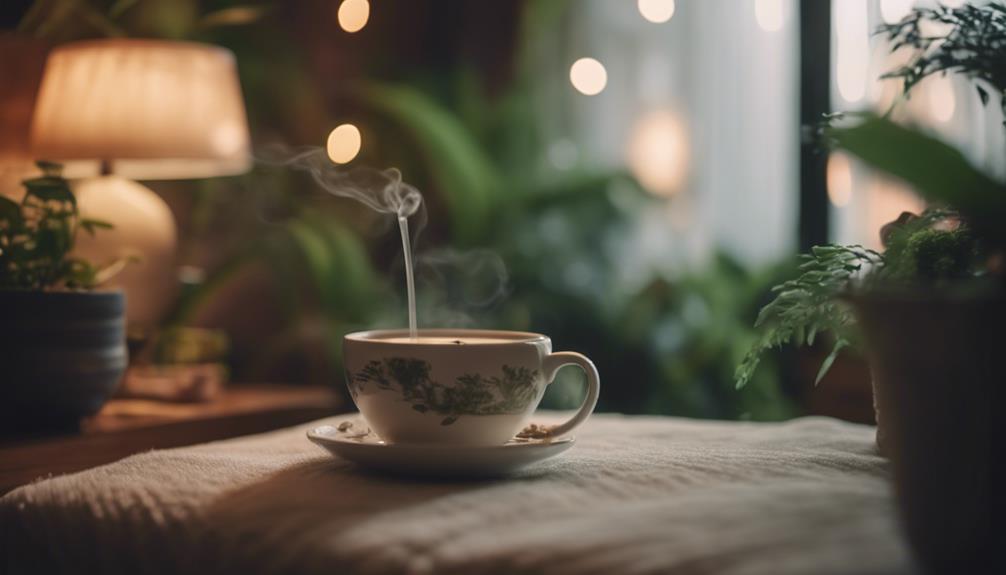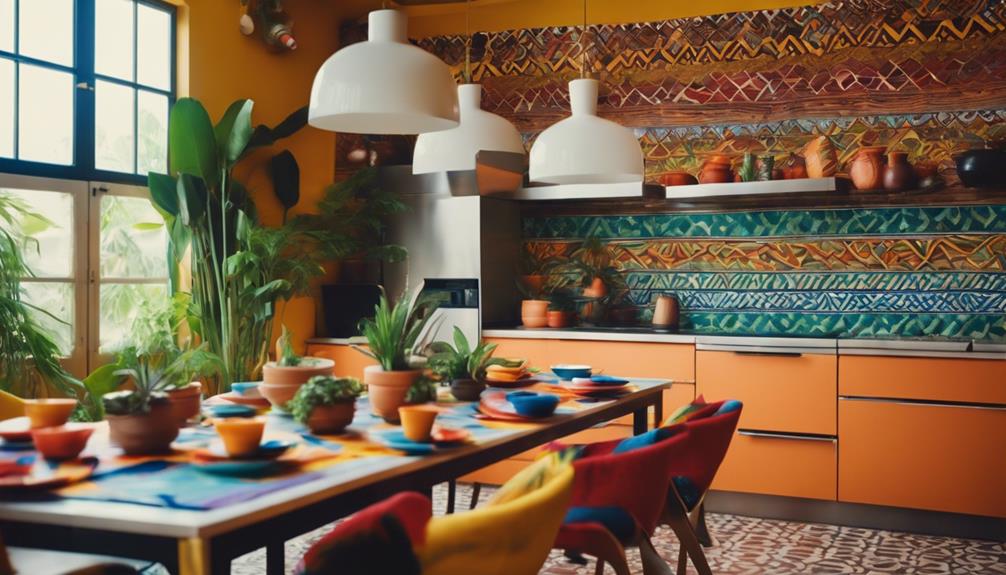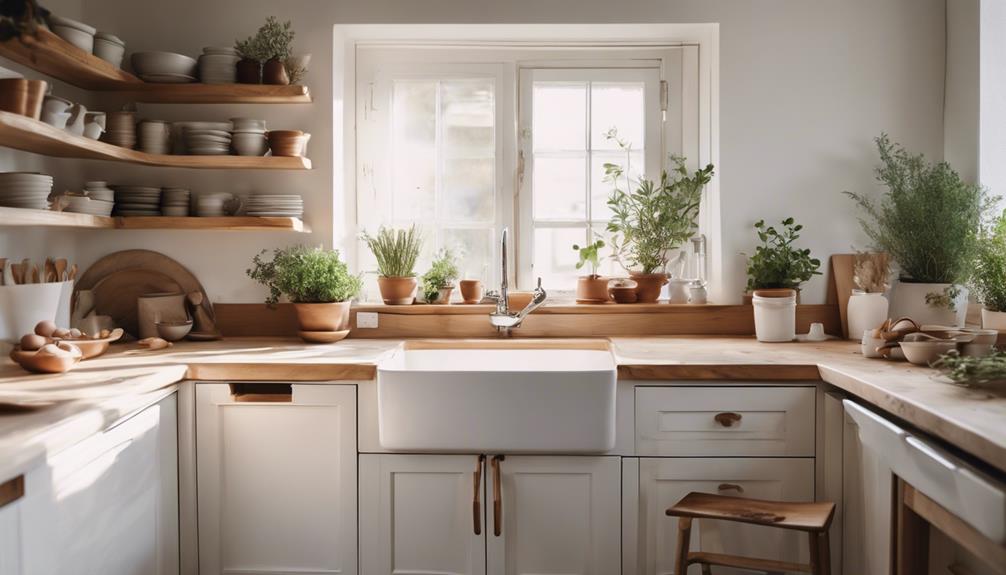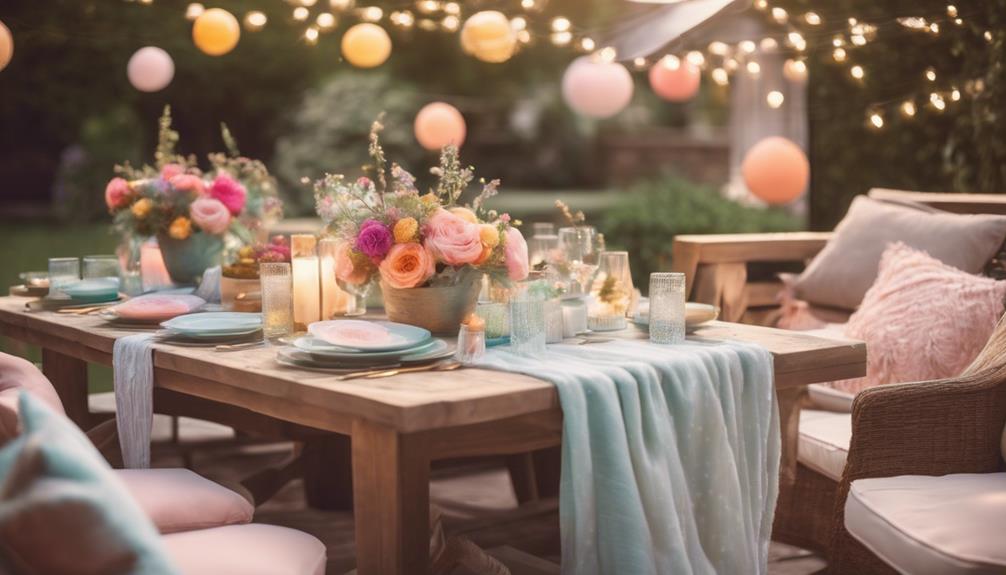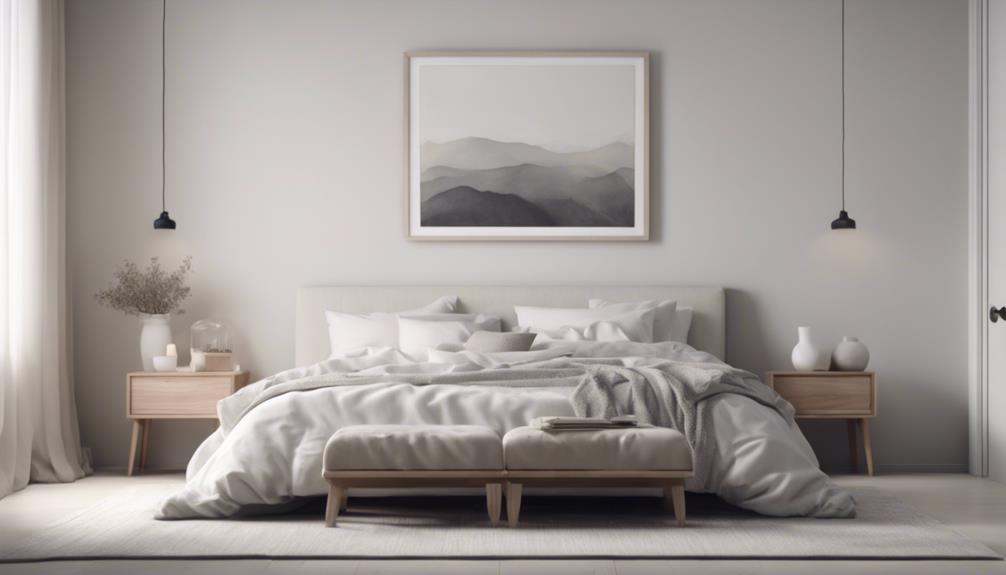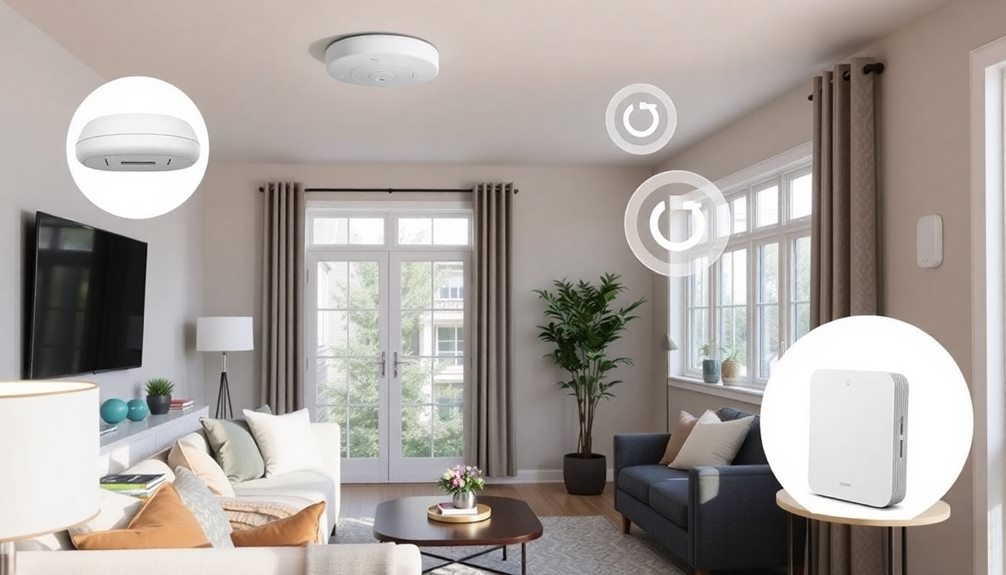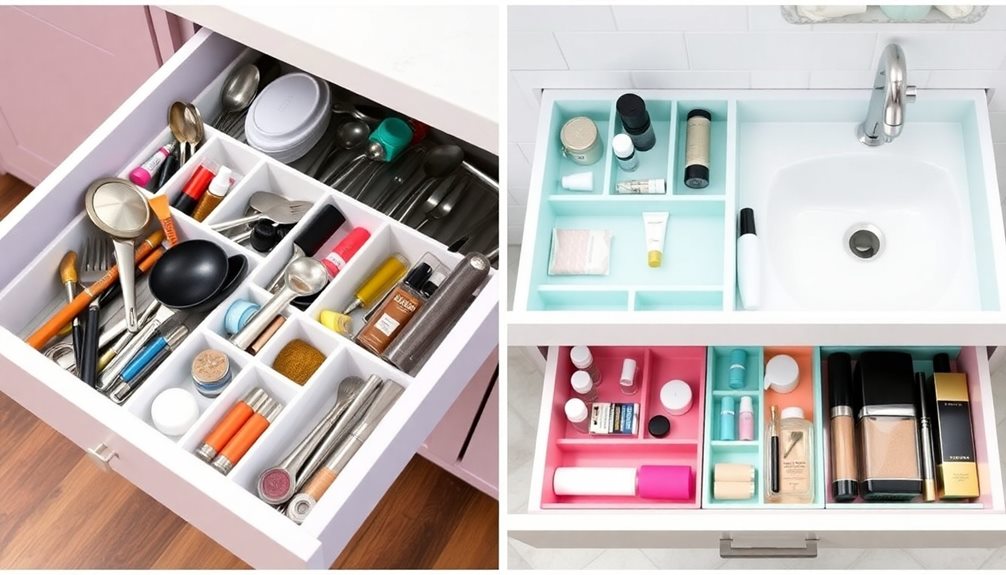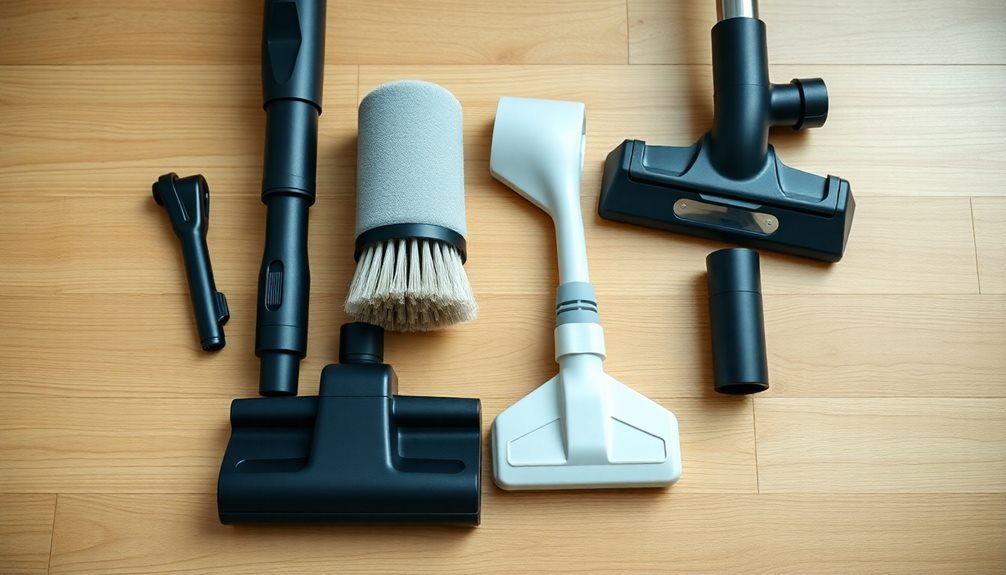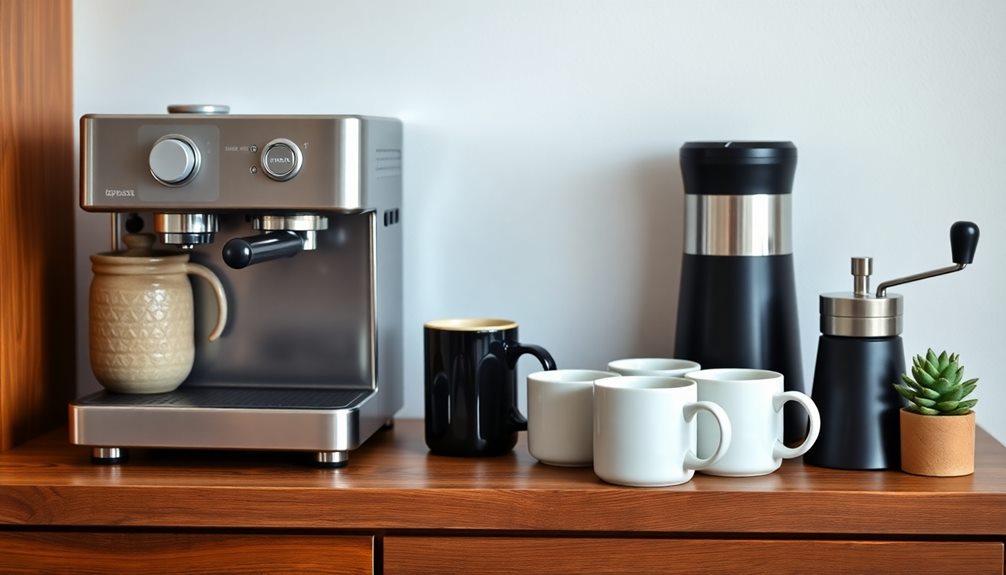Creating your ultimate relaxing sanctuary starts with making intentional choices that nurture your well-being. Choose calming colors like soft greens and warm neutrals to set a soothing tone. Incorporate aromatherapy with candles and essential oils to enhance the ambiance. Add houseplants to purify the air and reduce stress. Personalize your space with meaningful decor and soft textiles that invite comfort. Maximize natural light and use dimmable options for a serene atmosphere. Finally, designate hobby areas that spark joy. Embracing these tips will transform your home into a relaxing retreat, and there's so much more to explore to enrich your experience!
Key Takeaways
- Choose calming colors like soft greens and warm neutrals to create a tranquil atmosphere in your sanctuary.
- Incorporate aromatherapy using essential oils and scented candles to enhance relaxation and improve mood.
- Add indoor plants to purify air, reduce stress, and foster a connection to nature.
- Personalize your space with family photos and meaningful decor to create emotional comfort and uniqueness.
Understanding the Need for Relaxation
You often underestimate the importance of relaxation, especially when working from home has become the norm for many. Your home should be more than just a workspace; it should be a sanctuary that nurtures your mental well-being. With 45% of individuals now working from home, the need to create a peaceful environment is more essential than ever to reduce stress.
Investing in comfort within key living spaces like your bedroom and living room can greatly enhance your ability to unwind. Think about how you can transform these areas into sanctuaries that invite relaxation. This might include soft lighting, cozy fabrics, or even a dedicated space for mindfulness practices.
Establishing personal routines that promote relaxation not only sets a positive tone for your day but also helps you recharge mentally and emotionally after work hours. Engaging in self-care practices at home is essential for maintaining balance and ensuring you feel reconnected and rejuvenated.
Choosing Calming Colors
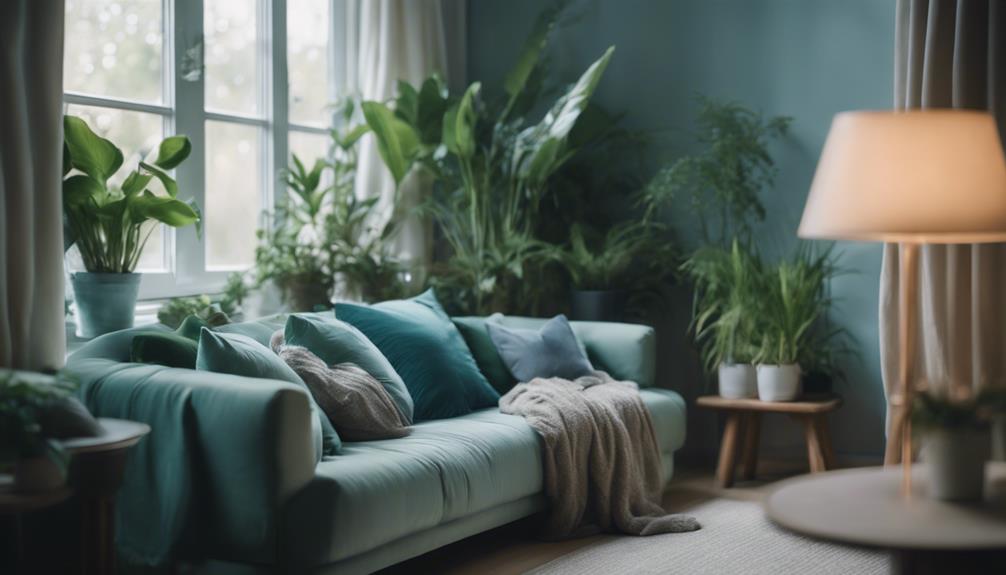
When it comes to creating your relaxing sanctuary, choosing calming colors is key.
Soothing palettes, like shades of blue and green, can greatly influence your emotional well-being.
Plus, considering your personal preferences will guarantee your space truly feels like a retreat.
Soothing Color Palettes
Soothing color palettes featuring shades of blue, beige, and soft greens create a serene atmosphere that invites relaxation into your home. When you choose calming colors, you're not just decorating; you're crafting an environment that can greatly impact your mood and well-being. Soft greens, for instance, are excellent for spaces like bedrooms and bathrooms, as they promote relaxation and tranquility.
Incorporating soothing tones can transform your living areas into a comforting retreat. Warm neutrals like taupe and soft cream foster a cozy ambiance, making your home feel inviting and secure. These colors enhance feelings of comfort, encouraging you to unwind after a long day.
While energizing colors like light yellow can elevate mood, they're better suited for spaces meant for activity and positivity. For relaxation, stick to the calming colors that help establish a harmonious flow throughout your home.
Thoughtful color selection is essential; it can enhance your overall emotional well-being. So, take a moment to explore these soothing palettes, and you'll create a peaceful sanctuary that truly nurtures your spirit.
Emotional Impact of Colors
Colors can profoundly affect your emotions, with calming shades like blue and soft greens creating a peaceful retreat that encourages relaxation. Choosing the right colors in your space can greatly improve your mood and emotional well-being. Here are three calming colors to reflect on:
- Soft Blue: This color promotes serenity and tranquility, making it ideal for bedrooms or relaxation areas.
- Gentle Green: Associated with nature, soft greens bring a rejuvenating and calming vibe, reducing stress and enhancing relaxation.
- Neutral Beige: Warm neutrals create a cozy atmosphere, fostering feelings of safety and comfort.
Incorporating these soothing colors into your home can help lower stress levels and create a tranquil environment.
While bright tones like yellow can boost energy, it's crucial to balance them with calming colors to maintain a peaceful mood.
Pay attention to how different shades make you feel, as personal preferences play an important role in color choice.
Personal Preference in Shades
Personal preferences in shades play a considerable role in how calming colors affect your space, allowing you to tailor your environment to suit your emotional needs and style.
For instance, if you find tranquility in shades of blue, incorporating them into your home can enhance your relaxation. Soft blues often evoke feelings of peace, while beige creates a warm, cozy atmosphere.
Consider warm neutrals like taupes and creams to make your space feel inviting. These colors provide comfort and can help you unwind after a long day. Earth tones, such as greens and browns, foster a connection to nature, promoting overall well-being.
When choosing calming colors, think about how they resonate with you personally. Your satisfaction with the space depends on how well these shades align with your preferences.
A harmonious color palette, combined with thoughtful lighting, can create a soothing ambiance that considerably reduces stress levels.
Utilizing Aromatherapy and Candles

Utilizing aromatherapy and candles creates a serene atmosphere that helps you unwind and enhances your overall well-being. By incorporating these elements into your sanctuary, you can greatly improve your relaxation experience. Here are three key benefits to reflect on:
- Mood Enhancement: Scents like lavender and eucalyptus not only smell great but also promote relaxation, reduce stress, and improve your mood.
- Aesthetic Appeal: Quality scented candles serve as decorative pieces, adding warmth and beauty to your space while elevating your home comfort.
- Air Quality Improvement: Essential oil diffusers offer a versatile alternative, filling your environment with soothing fragrances while also enhancing air quality.
Investing in both aromatherapy and scented candles is essential for creating that calming sanctuary you desire.
Whether you're lighting a candle after a long day or using a diffuser with your favorite essential oils, these small changes can make a big difference in how you feel.
Embrace the power of scent to transform your space into a relaxing haven where you can truly unwind and recharge.
Benefits of Incorporating Plants
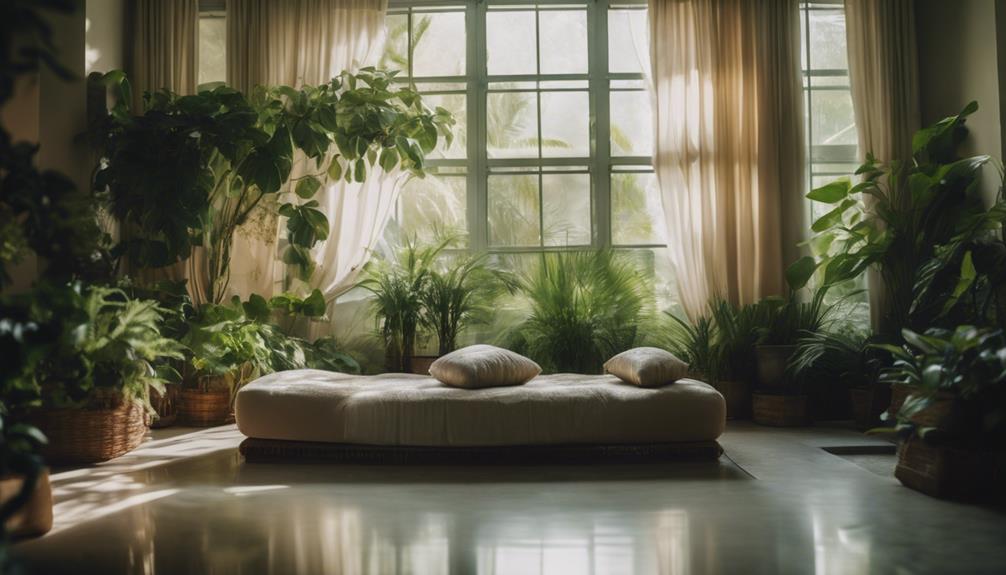
Incorporating plants into your sanctuary not only enhances aesthetics but also brings numerous mental and physical health benefits. By surrounding yourself with greenery, you create a peaceful environment that helps you relax and unwind after a long day. Studies show that interacting with plants can markedly lower cortisol levels, reducing stress and anxiety.
Moreover, houseplants purify the air, filtering out toxins that can negatively impact your health. If you're prone to allergies or asthma, adding plants to your space can lead to a healthier living environment. The growing popularity of indoor plants—sales increasing by up to 500%—demonstrates their positive impact on mental health and well-being.
Caring for your plants fosters a sense of responsibility and connection to nature, which enhances your overall emotional comfort. This connection can lead to greater satisfaction in your space, making it feel more like a sanctuary.
Personalizing Your Space
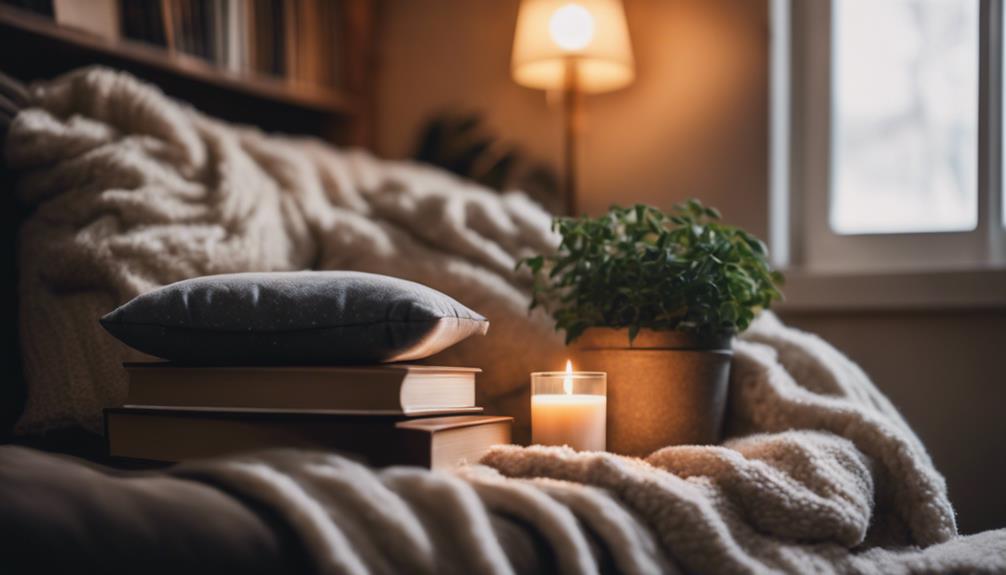
Surrounding yourself with elements that reflect your personality and interests can greatly enhance the comfort and appeal of your sanctuary. Personalizing your space is all about making it uniquely yours, and even small changes can create a cozy atmosphere that invites relaxation.
Here are three simple ways to start:
- Display Family Photos and Artwork: Incorporating meaningful artwork and pictures of loved ones fosters an emotional connection, making your space feel more inviting and comforting.
- Add Textures with Fabrics: Soft throw blankets and cushions can transform your environment. These tactile elements not only add comfort but also encourage you to unwind after a long day.
- Create Dedicated Hobby Areas: Whether it's a reading nook or a crafting zone, establishing spaces for your hobbies allows for personal expression and relaxation, making your sanctuary feel even more like home.
Importance of Lighting
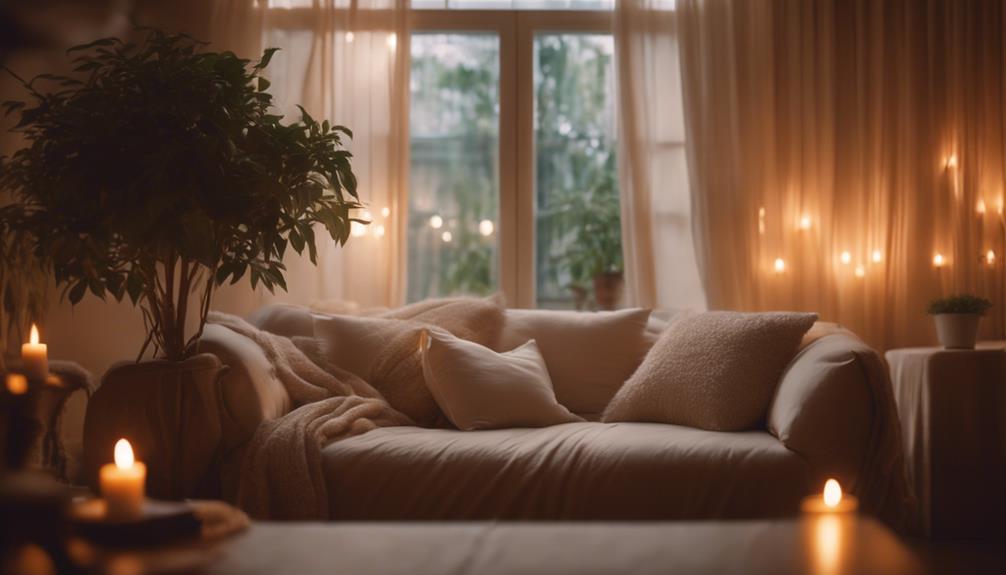
Lighting plays an essential role in transforming your sanctuary into a haven of relaxation and comfort. By maximizing natural light, you can energize your space and promote well-being. Positioning mirrors strategically can reflect sunlight, brightening up dark corners and creating an inviting atmosphere.
To create a home that feels cozy, incorporate soft, diffused lighting. Use lamps with warm-toned bulbs and shades that scatter light gently throughout the room. This type of lighting fosters a calming environment, perfect for unwinding after a long day.
Mix general, task, and accent lighting to tailor the ambiance for various activities. General lighting provides overall illumination, while task lighting focuses on areas where you read or work. Accent lighting can highlight artwork or architectural features, adding emotional depth and aesthetic appeal to your space.
Don't forget about dimmer switches! They allow you to adjust brightness levels easily, giving you the flexibility to switch from a lively atmosphere to a serene retreat.
Thoughtful lighting design not only enhances functionality but also elevates your mood, making your sanctuary a true escape from the outside world.
Creating Dedicated Hobby Areas
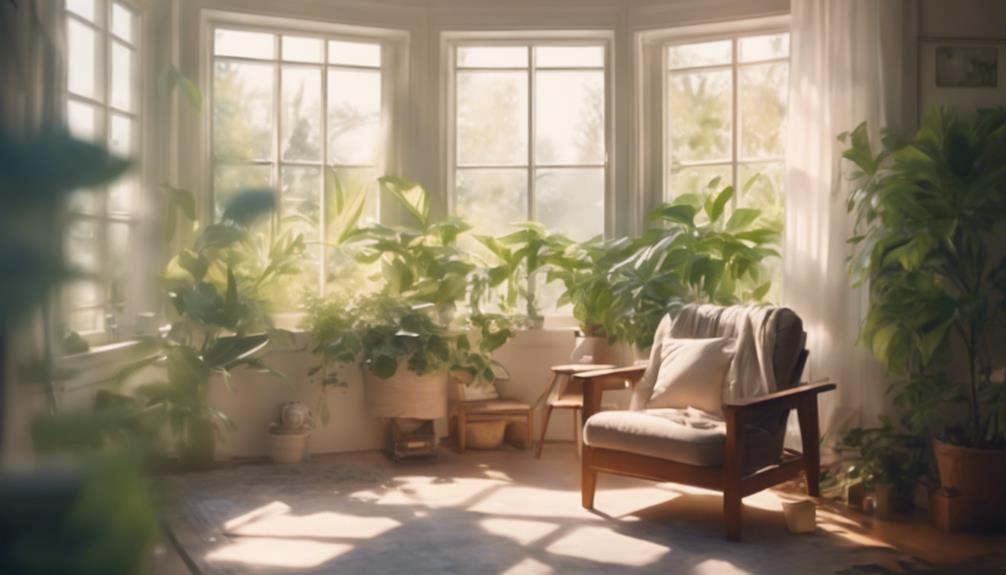
Creating dedicated hobby areas in your home can transform your space into a relaxing sanctuary.
By setting up cozy reading nooks, functional exercise areas, and designated crafting spaces, you give yourself the chance to unwind and enjoy your favorite activities.
These intentional setups not only enhance your relaxation but also help you stay focused and engaged in what you love.
Designated Crafting Spaces
Designate a specific area for crafting to boost your creativity and minimize distractions, ensuring a more focused and enjoyable experience. Creating designated crafting spaces in your home transforms it into a place of rest and inspiration.
Here are three essential tips to get started:
- Storage Solutions: Incorporate bins and shelves to organize your supplies. This reduces clutter and streamlines access, making your crafting sessions smoother and more enjoyable.
- Lighting: Choose a well-lit area, ideally with natural light. Good lighting improves your mood and concentration, allowing you to immerse yourself in your projects for longer periods without feeling drained.
- Personal Touches: Personalize your crafting space with uplifting decor, like inspirational quotes or your favorite artworks. This enhances your emotional connection to the space and keeps you motivated while you create.
Cozy Reading Nooks
A cozy reading nook can transform any corner of your home into a peaceful retreat where you can escape into your favorite books. To create the perfect space, start by selecting a comfortable armchair or chaise lounge that invites relaxation. Layer your nook with soft throw blankets and cushions to enhance comfort, making it the ideal spot for curling up with a great read.
Position your reading nook near a window to take advantage of natural light, which improves visibility and boosts your mood. This connection with nature can make you feel happy and more at ease while you immerse yourself in your stories.
Keep your collection organized by adding shelves or a small bookcase within reach, promoting a clutter-free environment that encourages focus and relaxation.
Functional Exercise Areas
Setting up functional exercise areas in your home not only encourages regular physical activity but also complements the comforting atmosphere of your cozy reading nook. By creating a dedicated space for workouts, you can enhance both your physical and mental well-being.
Here are three essential tips to design your exercise area:
- Choose Calming Colors: Opt for soft, soothing shades on the walls, like light blues or greens, to promote relaxation and focus during your workouts.
- Incorporate Essential Equipment: Equip your exercise area with mats, weights, and resistance bands that cater to your personal fitness goals. This variety will keep your routine exciting and effective.
- Add Personal Touches: Include inspirational quotes or artwork that resonates with you. These elements can uplift your mood and motivate you to stay committed to your exercise routine.
Ensure your exercise area is well-lit and ventilated, as natural light and fresh air enhance your motivation.
Establish a routine by scheduling dedicated workout times, making it easier to incorporate physical activity into your daily life. You'll find that a functional exercise area can elevate your entire relaxing sanctuary.
Designing for Comfort and Coziness
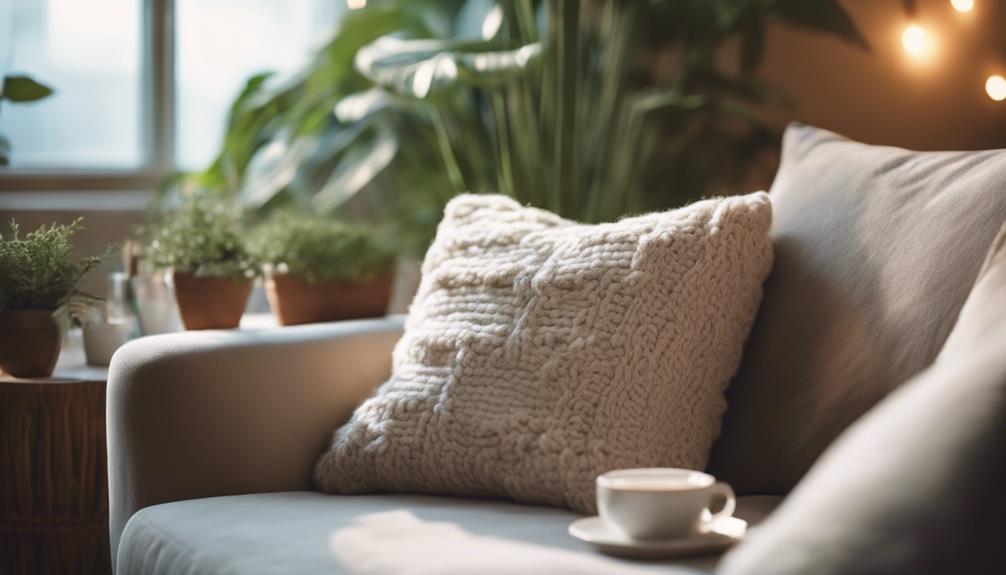
Creating a cozy retreat hinges on choosing plush furnishings and arranging them to invite comfort and connection. Start with inviting pieces like armchairs and chaise lounges that beckon you to unwind. Layer your space with soft throw blankets and an abundance of cushions and pillows made from natural materials like cotton, linen, and wool. These elements not only enhance tactile experiences but also create a soothing environment.
To design your relaxing sanctuary, consider how you arrange your seating. Position furniture to promote conversation and connection, so you can linger and enjoy moments of relaxation. This layout encourages an atmosphere where you can truly escape the stresses of the day.
Don't underestimate the power of lighting—utilize ambient sources like floor and table lamps to cast a soft, diffused glow. This warm illumination adds to the cozy ambiance, making your space feel inviting.
Fostering Connection and Community
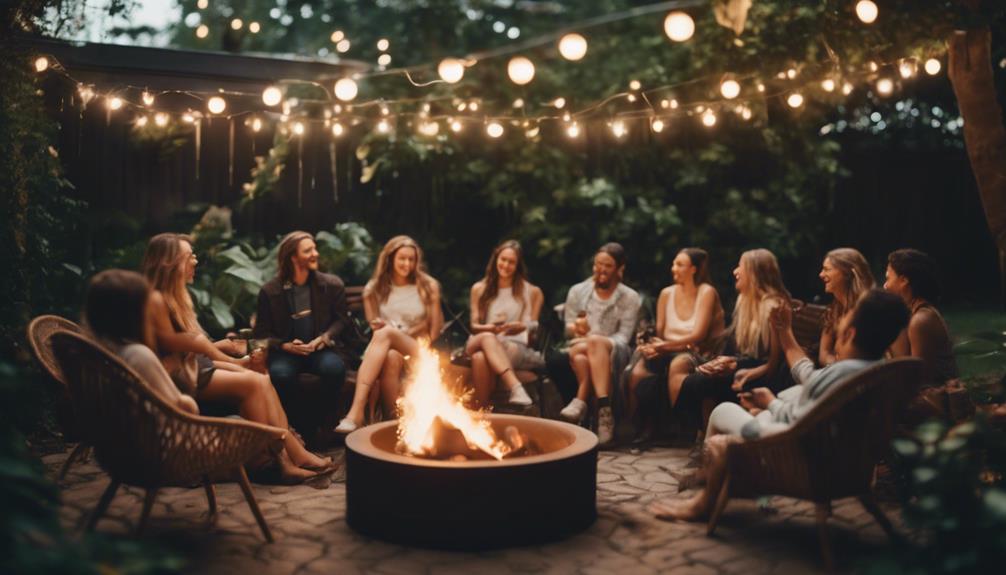
Inviting friends and family into your home cultivates a sense of community that deepens emotional connections and enriches your living space. Fostering connection through shared experiences not only creates lasting memories but also promotes emotional comfort.
Here are three ways you can enhance this in your home:
- Host Game Nights: Gather your loved ones for fun and laughter. Game nights encourage open communication and strengthen bonds while creating an enjoyable atmosphere.
- Celebrate Together: Whether it's a holiday or a simple dinner, celebrating special occasions together fosters joy and unity, making your home feel more meaningful.
- Create Dedicated Spaces: Design cozy areas for group activities, like a movie nook or a communal dining space. These areas invite togetherness and enhance the overall feel of your sanctuary.
Frequently Asked Questions
How to Create a Sanctuary for Yourself?
To create a sanctuary for yourself, designate cozy areas for relaxation, choose calming colors, add indoor plants, use soft lighting, and personalize your space with meaningful decor. It'll help you unwind and rejuvenate.
How to Make Your Room Your Sanctuary?
You might think transforming your room into a sanctuary is complicated, but it's simple. Choose calming colors, add plants, and personalize with photos. Soft lighting and soothing scents will complete your perfect, relaxing retreat.
How Do You Create a Peaceful Atmosphere?
To create a peaceful atmosphere, choose calming colors, use soft lighting, and add indoor plants. Incorporate personal decor and soothing scents like candles or essential oils, enhancing comfort and fostering tranquility in your space.
What Is a Sanctuary in a House?
A sanctuary in your house is more than just a space; it's a personal retreat. It's where you find peace, filled with calming colors, comfortable furniture, and cherished items that make you feel at home.
Conclusion
By transforming your space into a relaxing sanctuary, you're not just enhancing your environment—you're investing in your well-being.
Each thoughtful choice, from calming colors to the warmth of a cozy nook, plays an essential role in nurturing your mind and spirit.
Embrace the art of relaxation, much like a Renaissance painter wielding their brush, and watch as your life flourishes.
You deserve a haven that rejuvenates you, so start crafting your personal oasis today!
